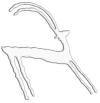Ērān ud Anērān
Webfestschrift Marshak 2003
[index]

Ērān ud Anērān |
Transoxiana
|
After the victory of the Turks over the Hephthalite armies near Nakhshab in 560s, Sogdiana was incorporated into the Turkish Qaghanate until the first quarter of VIIIth century. According to most researchers’ opinion, the Qaghanate did not involve itself in the internal administration of Sogdiana, ruled through members of local origin, limiting its intromissions in the Sogdian affairs to the taxes. Again, in their opinions, the Turkish administrators became more and more Iranized. But, several new sources and archaeological finds from the region show us that these opinions should be reexamined. Among these archaeological data there are some epigraphical, numismatic finds and the Sogdian documents found in Panjikent in 1932. They also must be compared with written sources in different languages, for example, Chinese ones such as dynastic chronicles (Beishi, Suishu and Tangshu).
According to Beishi and Suishu, in VIth-VIIth centuries the dynasty in Kash (Shahr-i Syabz) and then the Samarkand rulers hold in their hands the central control and effected on the local administrators in some countries such as Kushaniya, Fay, Maimurg, Kabudan, Ishtihan, Panjiknet and Nakhshab. For example, the origin of the administrators in Kang is shown as Chaowu dynasty. Though H. Gibb and O. Smirnova considered it as an Iranian people or a title from Yuezhi origin, Z.V.Togan interested it with Chumukun / Djamuks. The Turks first had ruled Sogdiana through the Chaowu when they conquered it, and then it seems that the Turks put an end to their rule. Some local rulers in Samarkand towards 600s established closely relationships with the Turkish Qaghanate and even married with some qaghans' daughters. This is the case of a marriage contract between Dugdgoncha, a Sogdian woman, and Ot-Tegin from Turkish aristocracy.
According to Tangshu, some changings occurred in the administration of Samarkand from 650. According to L. Albaum, Avarhuman (Fohoman in Chinese, 650-670) -a commander of the Turkish Qaghanate and the mmeber of one Turkish tribe- got control of Samarkand, and this city began to make leadership in this respect in Sogd, from the time of Fohoman on. Again, after 700s a dynastic change occurred in Samarkand, and one Touhoen was brought into the administration by the people, whose name is given as trγwn in Sogdian documents, and as Tarhun in Arabic sources. Some scholars consider it as a Turkish word (Tarkan). After 700 another person, Olekia succeeded him, whose name is known as 'wγrk (Ugrak), 'wr’kk (Urak) in Sogdian coins, and Ġhurek in Arabic sources. According to a family-tree in Abu Khafs an-Nasafi's work ("Abu Husayn Ubaydullah ibn al-Marzuban ibn Türkash Beķi ibn Kasir ibn Tarkhun ibn Benicur ibn Ghurek al-Babdastani"), he was possibly a Turk. According to Tangshu, Olekia appointed as governors Touho, one of his sons to Ts'ao city, and another, Mocho to Mi city (Maimurg). Smirnova accepted that the first name seems as twrγ'γ (Turgag) or twrγ'r (Turgar) in the coins minted by him, and not an Iranian but a Turkish word. As to the second name, it occurs again in Chinese name (Mocho) of Kapagan Qaghan (691-716) from the second Turkish Qaghanate. Once E. Chavannes had also pointed out this similarity, and P. Pelliot accepted his name as Begchor. In my opinion, the name (Mocho) in Chinese sources and the name (Benijur) in Arabic ones are the same and they are the same person different names in different languages. The using of a lot Turkish titles in Samarkand under the rule of Turkish Qaghanate also indicates that there was a dynasty from Turkish origin there.
Apart from Samarkand there were also other rulers from Turkish origin in other countries and cities, such as Panch (ck'yn cwr βylk’’: Chakyn Chor Bilge, Divashtich), Kash (for example, Chachepi: Shyshpyr), Nakhshab, Fay, Khuzar (Sü Bughra), Kabudan (Soto polo: Sutu Buğra).
As an earnest of progressing of the relations between Turkish and Sogdian peoples under the Turkish rule we meet them frequently not only in the political life but also in cultural and social areas. For example, it is said in Chinese sources that marriage and burial customs of the Kang (Sogd) and the Tujue (Turks) were the same. We know that the Turks also used the Sogdians' alphabet officially, and its most beautiful example is the Inscription in Bugut (Mongolia) and the coins relating to the Ancient Turks found in Yedisu (Semirech'e) and Transoxiana.
In turn, the Sogdian secretaries also took advantage of the Turkish language and alphabet because among the Sogdian documents found in Mugh there was also a document in Turkish: it is supposed that this was made up by Sogdian clerks who knew about Turkish grammar and lexicon. In those documents Turkish titles, phrases, words etc. were also used. Nowadays researchers also found some ceramic vessels written in Turkish and made by Sogdian craftsmen in Shahri-Syabz (Kash). One half of various epigraphical materials from VII-VIIIth centuries, for example, terracottas found near Samarkand and Kash, and the pictures in a palace of a ruler in Afrasiab and the Palace in Panjikent bear some Turkish characters. Again, the Sogdian administrators and notables were depicted in Turkish costume and style. Among them it is recorded a very important Turkish mourning ceremony.
Actualizado el 24/07/2004